JAMES BROWN / “Hit Me Three Times”
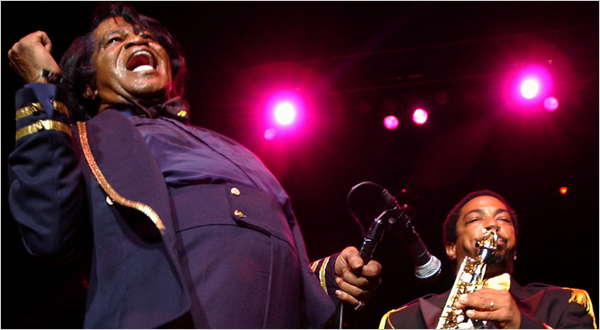 James Brown. Live at the Apollo in Harlem. The first great live R&B album. Recorded October 24, 1962. The band was Louis Hamblin – musical director and principal trumpet; Lucas “Fats” Gonder – emcee and organ; Teddy Washington – trumpet; Mack Johnson – trumpet; St. Clair Pinckney – principal tenor saxophone, solo on “Think”; Al “Brisco” Clark – tenor and baritone saxophones; Clifford MacMillan, aka “Ace King” – tenor saxophone; Dickie Wells – trombone (with band this engagement only); Les Buie – guitar, acting road manager; Hubert Perry – bass; Clayton Fillyau – principal drums; Sam Latham – drums. The Famous Flames, background singers, are Bobby Byrd – also organ on “Lost Someone” and intermittently throughout; Bobby Bennett and “Baby” Lloyd Stallworth.
Mr. Brown put up his own money to record this one because King Records did not want to indulge what was perceived as losing proposition. James Brown also was perceptive enough to mike the audience and to choose to record at The Apollo. Anyone with ears and even a modicum of affinity for R&B can appreciate this classic album.
James Brown. Live at the Apollo in Harlem. The first great live R&B album. Recorded October 24, 1962. The band was Louis Hamblin – musical director and principal trumpet; Lucas “Fats” Gonder – emcee and organ; Teddy Washington – trumpet; Mack Johnson – trumpet; St. Clair Pinckney – principal tenor saxophone, solo on “Think”; Al “Brisco” Clark – tenor and baritone saxophones; Clifford MacMillan, aka “Ace King” – tenor saxophone; Dickie Wells – trombone (with band this engagement only); Les Buie – guitar, acting road manager; Hubert Perry – bass; Clayton Fillyau – principal drums; Sam Latham – drums. The Famous Flames, background singers, are Bobby Byrd – also organ on “Lost Someone” and intermittently throughout; Bobby Bennett and “Baby” Lloyd Stallworth.
Mr. Brown put up his own money to record this one because King Records did not want to indulge what was perceived as losing proposition. James Brown also was perceptive enough to mike the audience and to choose to record at The Apollo. Anyone with ears and even a modicum of affinity for R&B can appreciate this classic album.
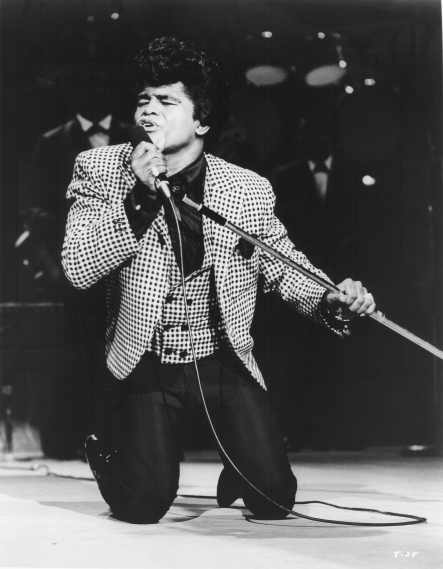 In 1962 James Brown was very much in his dynamic showman bag including his signature multiple capes routine in which he would sink to his knees, be covered with a cape and consoled by one of the background singers only to jump up energetically flinging off the cape to sing some more before sinking to his knees again. The routine some times lasted for fifteen minutes or more. During this period he had also perfected handling the mike stand, rocking it back and forth catching it as he dropped to the floor or did multiple twirls.
In 1962 James Brown was very much in his dynamic showman bag including his signature multiple capes routine in which he would sink to his knees, be covered with a cape and consoled by one of the background singers only to jump up energetically flinging off the cape to sing some more before sinking to his knees again. The routine some times lasted for fifteen minutes or more. During this period he had also perfected handling the mike stand, rocking it back and forth catching it as he dropped to the floor or did multiple twirls.
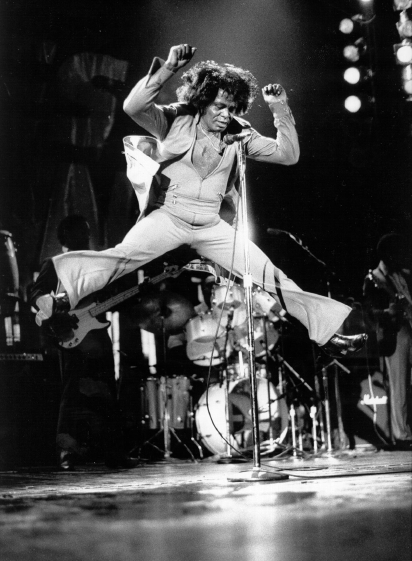 During this period he also established himself as the premiere dancer with a number of patented moves including the famous hyper-fast leg gyrations known as “The James Brown,” moves that no other dancer matched (yes, including Michael Jackson who was undoubtedly one of the best of all time).
By 1962 James Brown had begun putting together the classic funk sound that included two drummers and musicians who were well versed in jazz. Rather than multiple poly-rhythms from the drummers, Brown came up with a deep groove in which the guitar, the bass, the drums and the horns had a definitive rhythm pattern they locked into to create an undulating, syncopated tapestry of rhythm over which James Brown could sing, rap, and dance or lead horns could solo.
During this period he also established himself as the premiere dancer with a number of patented moves including the famous hyper-fast leg gyrations known as “The James Brown,” moves that no other dancer matched (yes, including Michael Jackson who was undoubtedly one of the best of all time).
By 1962 James Brown had begun putting together the classic funk sound that included two drummers and musicians who were well versed in jazz. Rather than multiple poly-rhythms from the drummers, Brown came up with a deep groove in which the guitar, the bass, the drums and the horns had a definitive rhythm pattern they locked into to create an undulating, syncopated tapestry of rhythm over which James Brown could sing, rap, and dance or lead horns could solo.
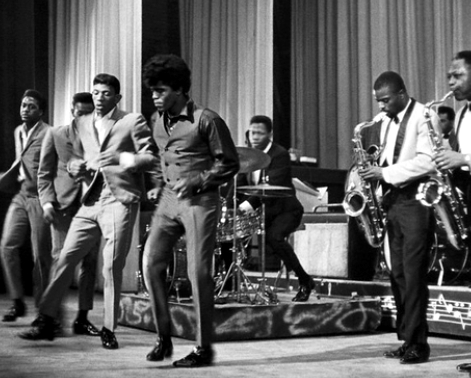 This is the foundation of funk being born but not yet fully realized. After this initial live recording James Brown would go on to produce numerous concert recordings including three others at The Apollo (1967, 1971 and 1995). For this week’s Classic Mixtape we will focus on the first three recordings which, take together, are a definitive illustration of how the style of music known as funk developed.
Live At The Apollo, Vol 2 exemplified the shift from blues based, to groove based music, the intermediate step on the way to flat out, fatabulous, fully-formed funk. By the late sixties the groove machine included violins and highly arranged music. While it was dynamic it was not yet knee deep in the funk.
The groove band was: Waymond Reed and Joe Dupars – trumpet; Levi Rasbury – valve trombone, emcee; Alfred “Pee Wee” Ellis – music director, alto saxophone, organ; Maceo Parker and Eldee Williams – tenor saxophone; St. Clair Pinckney – tenor & baritone saxophones; Jimmy Nolen – guitar; Alfonzo Kellum – guitar, bass; Bernard Odum – bass; John “Jabo” Starks and Clyde Stubblefield – drums; Ronald Selico – bongos, drums; Vivian Robinson, Richard Jones, Marilyn Jones – violins; Bobby Byrd and Bobby Bennett – The Famous Flames.
Although I’ve read his autobiography and interviews with numerous band members, I am not certain from where James Brown got his ideas, nor do I know what specifically led him through the three phases. We could easily point to Louis Jordan and undoubtedly would also have to acknowledge Jackie Wilson but that would only account for Phase 1. Phase 2 was Mr. Brown innovating and jacking the music up a huge notch. But then came Phase 3 (“the funk”) and make no mistake this was a musical revolution.
My belief is that the politics led to aesthetic changes. By the seventies James was riding the wave of political activism then current throughout Black communities in the seventies. You can listen to the lyrics. You can look at the band uniforms (which included dashikis for a short period), and in particular you can look at James’ personal presentation.
This is the foundation of funk being born but not yet fully realized. After this initial live recording James Brown would go on to produce numerous concert recordings including three others at The Apollo (1967, 1971 and 1995). For this week’s Classic Mixtape we will focus on the first three recordings which, take together, are a definitive illustration of how the style of music known as funk developed.
Live At The Apollo, Vol 2 exemplified the shift from blues based, to groove based music, the intermediate step on the way to flat out, fatabulous, fully-formed funk. By the late sixties the groove machine included violins and highly arranged music. While it was dynamic it was not yet knee deep in the funk.
The groove band was: Waymond Reed and Joe Dupars – trumpet; Levi Rasbury – valve trombone, emcee; Alfred “Pee Wee” Ellis – music director, alto saxophone, organ; Maceo Parker and Eldee Williams – tenor saxophone; St. Clair Pinckney – tenor & baritone saxophones; Jimmy Nolen – guitar; Alfonzo Kellum – guitar, bass; Bernard Odum – bass; John “Jabo” Starks and Clyde Stubblefield – drums; Ronald Selico – bongos, drums; Vivian Robinson, Richard Jones, Marilyn Jones – violins; Bobby Byrd and Bobby Bennett – The Famous Flames.
Although I’ve read his autobiography and interviews with numerous band members, I am not certain from where James Brown got his ideas, nor do I know what specifically led him through the three phases. We could easily point to Louis Jordan and undoubtedly would also have to acknowledge Jackie Wilson but that would only account for Phase 1. Phase 2 was Mr. Brown innovating and jacking the music up a huge notch. But then came Phase 3 (“the funk”) and make no mistake this was a musical revolution.
My belief is that the politics led to aesthetic changes. By the seventies James was riding the wave of political activism then current throughout Black communities in the seventies. You can listen to the lyrics. You can look at the band uniforms (which included dashikis for a short period), and in particular you can look at James’ personal presentation.
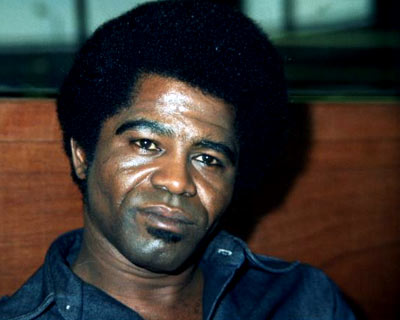 The “conk” was gone replaced by a natural “afro” hair style. Indeed, Volume 3 of the Apollo recordings is titled Revolution of the Mind. The artwork shows James Brown behind bars on the cover and on the inside flaps James is shown sitting in a jail cell, as well as coming out of jail giving a black power salute. The music itself is equally fierce.
For those who enjoy tracing influences, you can see easily hear how deeply James Brown influenced Fela Kuti and Nigerian afro-beat music. The funk ensemble was Jerone Sanford and Russell Crimes – trumpet; Fred Wesley – trombone; Jimmy Parker – alto saxophone; St. Clair Pinckney – tenor saxophone; Bobby Byrd – organ, vocals; Hearton “Cheese” Martin and Robert Coleman – guitar; Fred Thomas – bass; John “Jabo” Starks and John Morgan – drums; Danny Ray – emcee. Additionally, James Brown plays organ on “Make It Funky.”
The “conk” was gone replaced by a natural “afro” hair style. Indeed, Volume 3 of the Apollo recordings is titled Revolution of the Mind. The artwork shows James Brown behind bars on the cover and on the inside flaps James is shown sitting in a jail cell, as well as coming out of jail giving a black power salute. The music itself is equally fierce.
For those who enjoy tracing influences, you can see easily hear how deeply James Brown influenced Fela Kuti and Nigerian afro-beat music. The funk ensemble was Jerone Sanford and Russell Crimes – trumpet; Fred Wesley – trombone; Jimmy Parker – alto saxophone; St. Clair Pinckney – tenor saxophone; Bobby Byrd – organ, vocals; Hearton “Cheese” Martin and Robert Coleman – guitar; Fred Thomas – bass; John “Jabo” Starks and John Morgan – drums; Danny Ray – emcee. Additionally, James Brown plays organ on “Make It Funky.”
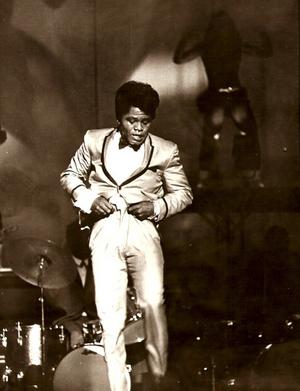 Although comparing and contrasting selections from the three early Apollo recordings illustrates the development of funk, this is not a retrospective of James’ career, nor is it a greatest hits compilation. My task was just to illustrate how three particular live albums, all of them recorded at The Apollo, give us a broad overview of the conceiving, gestation and birth of the music we know as funk.
—Kalamu ya Salaam
Hit Me Three Times Mixtape Playlist
Although comparing and contrasting selections from the three early Apollo recordings illustrates the development of funk, this is not a retrospective of James’ career, nor is it a greatest hits compilation. My task was just to illustrate how three particular live albums, all of them recorded at The Apollo, give us a broad overview of the conceiving, gestation and birth of the music we know as funk.
—Kalamu ya Salaam
Hit Me Three Times Mixtape Playlist
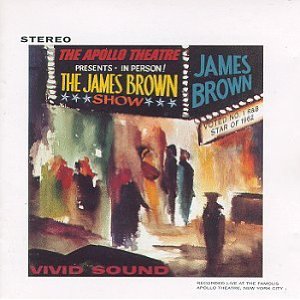 Live At The Apollo [1963]
01 “Think”
02 “Instrumental Bridge 2”
03 “I Don't Mind”
04 “Instrumental Bridge 3”
05 “Lost Someone”
06 “Medley: Please, Please, Please / You've Got The Power”
Live At The Apollo [1963]
01 “Think”
02 “Instrumental Bridge 2”
03 “I Don't Mind”
04 “Instrumental Bridge 3”
05 “Lost Someone”
06 “Medley: Please, Please, Please / You've Got The Power”
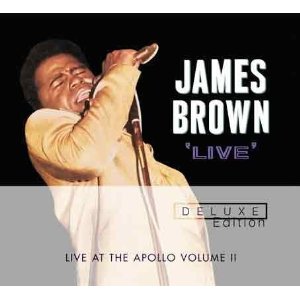 Live At The Apollo [1968]
07 “There Was A Time”
08 “I Feel All Right”
09 “Cold Sweat”
10 “Prisoner Of Love”
11 “It's A Man's, Man's, Man's World”
Live At The Apollo [1968]
07 “There Was A Time”
08 “I Feel All Right”
09 “Cold Sweat”
10 “Prisoner Of Love”
11 “It's A Man's, Man's, Man's World”
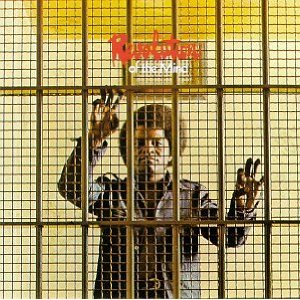 Revolution Of The Mind: Live At The Apollo [1971]
12 “Make It Funky”
13 “Soul Power”
14 “Hot Pants”
Revolution Of The Mind: Live At The Apollo [1971]
12 “Make It Funky”
13 “Soul Power”
14 “Hot Pants”
This entry was posted on Monday, April 12th, 2010 at 1:55 am and is filed under Classic. You can follow any responses to this entry through the RSS 2.0 feed. You can leave a response, or trackback from your own site.
2 Responses to “JAMES BROWN / “Hit Me Three Times””
April 12th, 2010 at 11:27 am
You’ve got to give credit to Michael Jackson during the BET awards draping the cape over James Brown back in the mid 2000’s. I remember it so vividly. Classic TV!!!
Leave a Reply
| top |